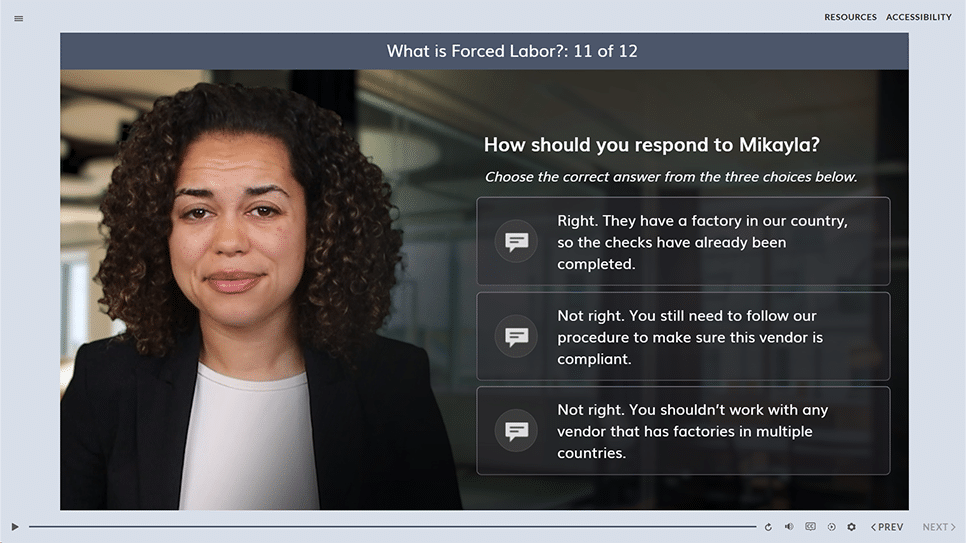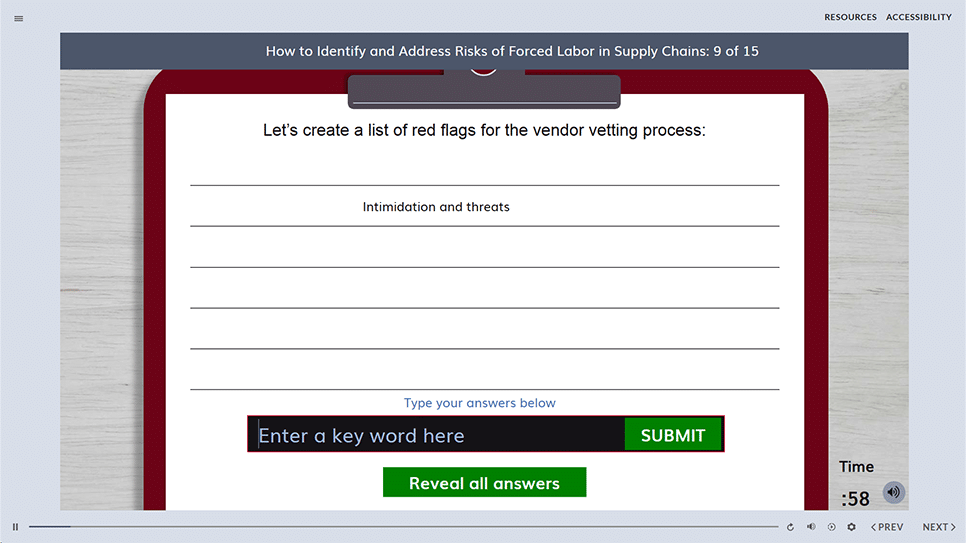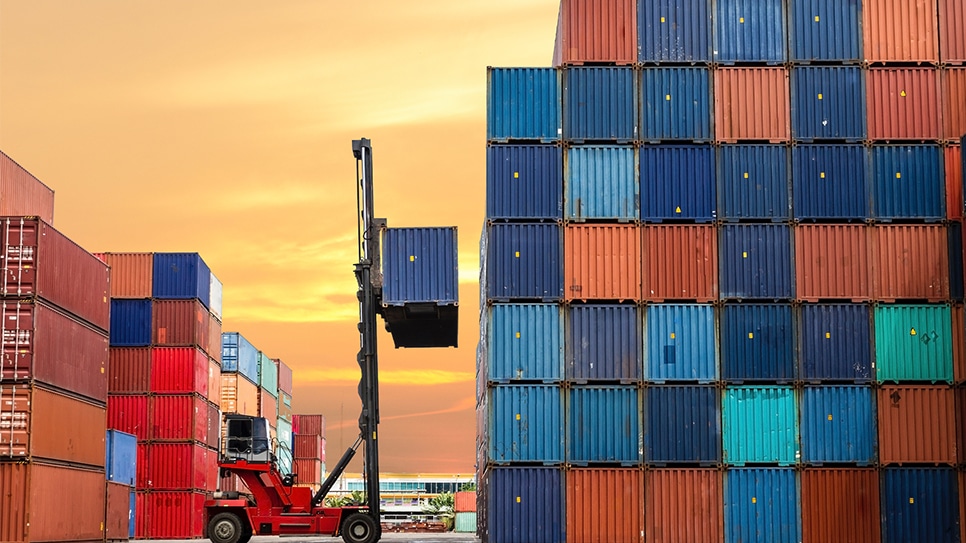
Forced Labor in Global Supply Chains
Empower your employees to identify forced labor within the production, delivery, and supply chain processes.
Course description
Traliant’s Forced Labor in Global Supply Chains training is a 20-minute course designed for all employees involved in supply chain operations, including those who manage relationships with vendors, suppliers, and partners. The training addresses the worldwide issue of forced labor and educates employees on their critical role in eradicating it, including how to assess risks and spot warning signs. Additionally, the course covers forced labor laws in the United States, United Kingdom, Canada, Mexico, and Australia.
ONLINE TRAINING
Forced Labor in Global Supply Chains

The course covers these topics and more:
- What is Forced Labor?
- Forced labor as defined by the International Labor Organization (ILO)
- Child labor
- Human Trafficking
- Goods linked to forced labor
- Factors linked to forced labor
- Forced labor laws in the US, Australia, Canada, Mexico, and UK
- Identifying and addressing risks
- ILO indicators of forced labor
- Vendor inspections
- Ongoing supply chain due diligence
- Reporting concerns
THE TRALIANT DIFFERENCE
Compliance you can trust.
Training you will love.

Legal expertise
Our in-house legal team monitors the latest laws, rules and regulations, so you don't have to. You can rest assured that our courses are continuously compliant.

Brilliant training
Take your training from boring to brilliant. With cinematic-quality videos produced by our Hollywood-based team, your employees will love our customizable, interactive, story-based training.

Valued partnership
Our main focus? It’s all about making your job easier. We do that with unmatched responsiveness and seamless deployment, dedicated to driving your success.

Meaningful impact
We don’t just deliver brilliant training, we help you create meaningful impact by broadening your employees' perspectives, achieving compliance and elevating culture.
KEY FEATURES
Why you'll love our training
It’s time to embrace a new era of online training with a valued partner who will ensure seamless implementation to fit your exact, a truly enjoyable learning experience and courses with continuous compliance you can trust.
Compliance expertise
Traliant's in-hour legal expertise ensures training is accurate and kept up-to-date with any regulatory changes.
Accessible to users with disabilities
Traliant provides an inclusive experience for all users, including those with disabilities, by going beyond Section 508-C standards and offering WCAG 2.1 AA.
Story-based learning
Our story-based approach blends leading instructional design with Hollywood talent to produce engaging, interactive and nuanced training.
Course administration
Traliant makes it simple to roll out training to your workplace and provide technical support directly to your employees at no additional cost.
Course customizations
Tailor courses to include your logo, relevant policies, workplace images, and more. Traliant can even customize the course with scenarios that take place in your own workplace environment.
Translations
Training is available in English, Spanish and is supported in over 100 languages.
COMPLIANCE EXPERTISE
Your partner in training compliance

Uniquely qualified in-house compliance team
Our exceptional in-house Compliance Advisory Team is led by Michael Johnson, Chief Strategy Officer and former U.S. Department of Justice attorney who has provided training and guidance to organizations like the Equal Employment Opportunity Commission, Google, the United Nations, and the World Bank.

Keeping you compliant, effortlessly
Keeping up with the complex web of employment laws — especially if your workforce spans multiple states — can be tricky. That’s why we offer a streamlined training solution that ensures you stay compliant with federal, state, and local regulations, so you can focus on what matters most: your team.

Simplifying your policies and handbooks
Crafting an employee handbook that meets legal standards can be daunting. Let us ease the burden. We help you navigate regulatory changes to ensure your policies and handbooks not only comply with the law but also reflect industry best practices.
What to consider when choosing the most effective forced labor training

- Ensure legal compliance: Many countries have laws prohibiting forced labor, including the United States, the United Kingdom, Canada, Mexico, and Australia. Training helps organizations to comply with these laws and to avoid fines and penalties.
- Promote ethical sourcing: Forced labor in global supply chains training helps organizations to source products and materials ethically and to avoid working with suppliers who engage in forced labor.
- Enhance the organization's reputation: Forced labor practices can damage a company's reputation and erode trust with customers and stakeholders. Training helps to create a culture of ethical sourcing and to protect the company's image.
- Empower employees: Training provides employees with the knowledge and skills they need to understand forced labor and to recognize potential risks in the supply chain.
- Strengthen your organization's commitment to ethical business practices: Training helps to demonstrate the company's commitment to ethical sourcing and to create a culture where employees are aware of the risks associated with forced labor.
- Reduce the risk of legal and reputational issues: Forced labor can lead to legal and reputational issues for organizations.
- Debt bondage: People are forced to work to pay off a debt that they cannot afford to repay.
- Human trafficking: People are recruited, transported, or harbored through force, fraud, or coercion for the purpose of exploitation, including forced labor.
- Forced labor in prison: Prisoners are forced to work without proper compensation or with limited rights.
- Poverty and lack of economic opportunity: People who are living in poverty or who lack access to education and employment opportunities may be more vulnerable to forced labor.
- Weak laws and enforcement: In some countries, laws against forced labor are weak or not enforced effectively.
- Demand for cheap labor: The demand for cheap labor in certain industries, such as agriculture, manufacturing, and construction, can create incentives for companies to use forced labor.
- Employees are recruited with false promises.
- Employees are not paid for their work, or they are paid very low wages.
- Employees are forced to work long hours without breaks.
- Employees are not allowed to leave their workplace or to communicate with their families.
- Employees are threatened or physically abused.
- Conduct due diligence: Carefully investigate your suppliers and their labor practices.
- Develop a code of conduct: Set clear standards for ethical labor practices in your supply chain.
- Provide training: Train your employees about forced labor and how to identify and report potential risks.
- Monitor your suppliers: Regularly monitor your suppliers to ensure they are complying with your code of conduct and with labor laws.









